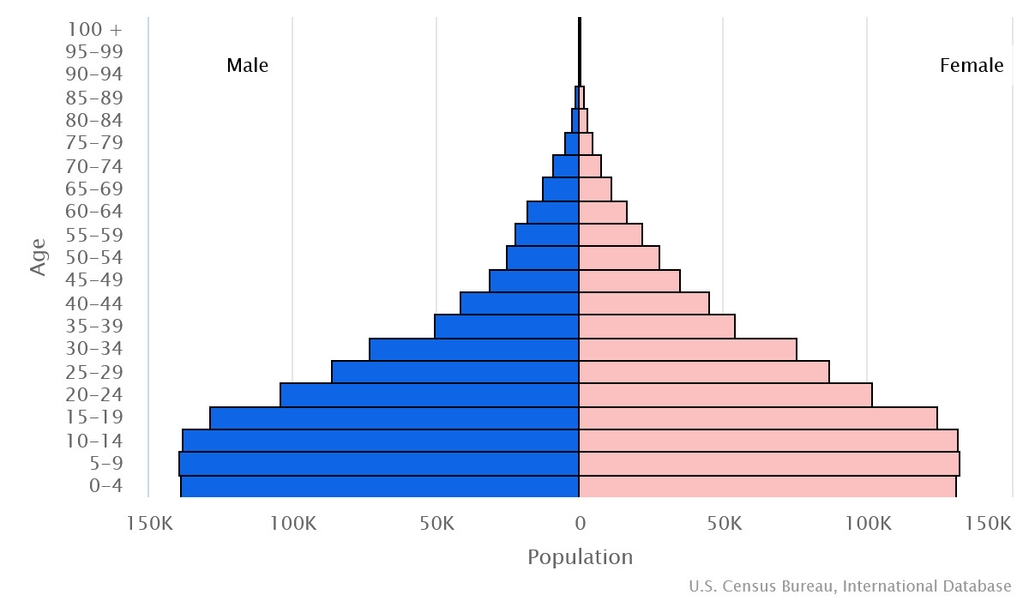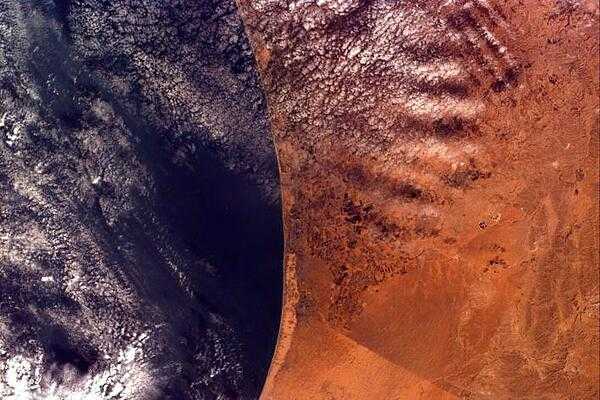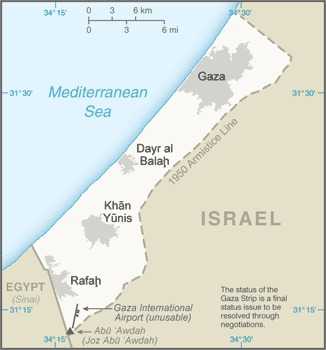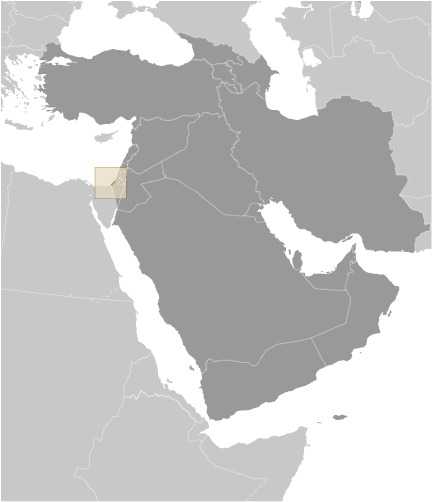Introduction
Background
The Gaza Strip has been under the de facto governing authority of the Islamic Resistance Movement (HAMAS) since 2007 and has faced years of conflict, poverty, and humanitarian crises. Inhabited since at least the 15th century B.C., the Gaza Strip area has been dominated by many different peoples and empires throughout its history; it was incorporated into the Ottoman Empire in the early 16th century. The Gaza Strip fell to British forces during World War I, becoming a part of the British Mandate of Palestine. Following the 1948 Arab-Israeli War, Egypt administered the newly formed Gaza Strip; Israel captured it in the Six-Day War in 1967. Under a series of agreements known as the Oslo Accords signed between 1993 and 1999, Israel transferred to the newly-created Palestinian Authority (PA) security and civilian responsibility for many Palestinian-populated areas of the Gaza Strip, as well as the West Bank.
In 2000, a violent intifada or uprising began in response to perceived Israeli provocations, and in 2001, negotiations to determine the permanent status of the West Bank, East Jerusalem, and Gaza Strip stalled. Subsequent attempts to re-start negotiations have not resulted in progress toward determining final status and resolving the Israeli-Palestinian conflict. Israel in 2005 unilaterally withdrew all of its settlers and soldiers and dismantled its military facilities in the Gaza Strip, but it continues to control the Gaza Strip’s land borders, maritime territorial waters, cyberspace, telecommunications, and airspace. In 2006, HAMAS won a majority in the Palestinian Legislative Council election. Fatah, the dominant Palestinian political faction in the West Bank, and HAMAS failed to maintain a unity government, leading to violent clashes between their respective supporters and HAMAS's violent seizure of all PA military and governmental institutions in the Gaza Strip in 2007. Since HAMAS's takeover, Israel and Egypt have enforced tight restrictions on movement and access of goods and individuals into and out of the territory. Fatah and HAMAS have since negotiated a series of agreements aimed at restoring political unity between the Gaza Strip and the West Bank but have struggled to enact them.
Palestinian militants in the Gaza Strip and the Israel Defense Forces periodically exchange projectiles and air strikes, respectively, threatening broader conflict. In 2021, HAMAS launched rockets into Israel, sparking an 11-day conflict that also involved other Gaza-based militant groups. Egypt, Qatar, and the UN Special Coordinator for the Middle East Peace Process negotiated ceasefires, averting a broader conflict. Since 2018, HAMAS has coordinated demonstrations along the Gaza-Israel security fence. HAMAS has also stood by while other militant groups, such as Palestinian Islamic Jihad, fought brief conflicts with Israel, most recently in August 2022 and May 2023.On 7 October 2023, HAMAS militants inside the Gaza Strip launched a combined unguided rocket and ground attack into Israel. The attack began with a barrage of more than 3,000 rockets fired toward Israel from Gaza, and included thousands of terrorists infiltrating Israel by land, sea, and air via paragliders. Militants attacked military bases, clashed with security forces mostly in southern Israel, and simultaneously infiltrated civilian communities. During the attack, terrorists carried out massacres and murdered civilians, including torture, acts of abuse and rape, a massacre at the Supernova music festival near Kibbutz Re'im, as well as kidnapping approximately 240 civilians, including men, women, children, and soldiers. These attacks were followed soon after by Israeli Defense Forces (IDF) air strikes inside Gaza. The next day, Israeli Prime Minister NETANYAHU formally declared war on Gaza. The IDF on 28 October launched a large-scale ground assault inside Gaza that is ongoing as of April 2024.
Visit the Definitions and Notes page to view a description of each topic.
Geography
Location
Middle East, bordering the Mediterranean Sea, between Egypt and Israel
Geographic coordinates
31 25 N, 34 20 E
Map references
Middle East
Area - comparative
slightly more than twice the size of Washington, DC
Land boundaries
total: 72 km
border countries (2): Egypt 13 km; Israel 59 km
Coastline
40 km
Maritime claims
see entry for Israel note: effective 3 January 2009, the Gaza maritime area is closed to all maritime traffic and is under blockade imposed by Israeli Navy until further notice
Climate
temperate, mild winters, dry and warm to hot summers
Terrain
flat to rolling, sand- and dune-covered coastal plain
Elevation
highest point: Abu 'Awdah (Joz Abu 'Awdah) 105 m
lowest point: Mediterranean Sea 0 m
Natural resources
arable land, natural gas
Irrigated land
(2013) 151 sq km; note - includes the West Bank
Population distribution
population concentrated in major cities, particularly Gaza City in the north
Natural hazards
droughts
Geography - note
once a strategic strip of land along Mideast-North African trade routes that has experienced an incredibly turbulent history
People and Society
Population
total: 2,141,643
male: 1,086,340
female: 1,055,303 (2024 est.)
comparison rankings: female 149; male 148; total 148
Nationality
noun: NA
adjective: NA
Ethnic groups
Palestinian Arab
Languages
Arabic, Hebrew (spoken by many Palestinians), English (widely understood)
major-language sample(s):
كتاب حقائق العالم، المصدر الذي لا يمكن الاستغناء عنه للمعلومات الأساسية (Arabic)
The World Factbook, the indispensable source for basic information.
Religions
Muslim 98.0 - 99.0% (predominantly Sunni), Christian <1.0%, other, unaffiliated, unspecified <1.0% (2012 est.)
note: Israel dismantled its settlements in September 2005; Gaza has had no Jewish population since then
Age structure
0-14 years: 38.8% (male 427,450/female 404,288)
15-64 years: 58.3% (male 627,235/female 620,903)
65 years and over: 2.9% (2024 est.) (male 31,655/female 30,112)

Dependency ratios
total dependency ratio: 74.3
youth dependency ratio: 68.2
elderly dependency ratio: 6.1
potential support ratio: 16.5 (2021 est.)
note: data represent Gaza Strip and the West Bank
Median age
total: 19.5 years (2024 est.)
male: 19.3 years
female: 19.8 years
comparison ranking: total 208
Population distribution
population concentrated in major cities, particularly Gaza City in the north
Urbanization
urban population: 77.6% of total population (2023)
rate of urbanization: 2.85% annual rate of change (2020-25 est.)
note: data represent Gaza Strip and the West Bank
Major urban areas - population
778,000 Gaza (2023)
Sex ratio
at birth: 1.06 male(s)/female
0-14 years: 1.06 male(s)/female
15-64 years: 1.01 male(s)/female
65 years and over: 1.05 male(s)/female
total population: 1.03 male(s)/female (2024 est.)
Maternal mortality ratio
20 deaths/100,000 live births (2020 est.)
note: data represent Gaza Strip and the West Bank
comparison ranking: 126
Infant mortality rate
total: 15.1 deaths/1,000 live births (2024 est.)
male: 16.3 deaths/1,000 live births
female: 13.8 deaths/1,000 live births
comparison ranking: total 91
Life expectancy at birth
total population: 75.5 years (2024 est.)
male: 73.7 years
female: 77.4 years
comparison ranking: total population 126
Gross reproduction rate
1.58 (2024 est.)
Contraceptive prevalence rate
57.3% (2019/20)
note: includes Gaza Strip and West Bank
Drinking water source
improved: urban: 98.9% of population
rural: 99% of population
total: 98.9% of population
unimproved: urban: 1.1% of population
rural: 1% of population
total: 1.1% of population (2020 est.)
note: includes Gaza Strip and the West Bank
Physician density
2.71 physicians/1,000 population (2020)
Hospital bed density
1.3 beds/1,000 population (2019)
Sanitation facility access
improved: urban: 99.9% of population
rural: 98.6% of population
total: 99.6% of population
unimproved: urban: 0.1% of population
rural: 1.4% of population
total: 0.4% of population (2020 est.)
note: note includes Gaza Strip and the West Bank
Major infectious diseases
note: on 21 March 2022, the US Centers for Disease Control and Prevention (CDC) issued a Travel Alert for polio in Asia; the Gaza Strip is currently considered a high risk to travelers for polio; the CDC recommends that before any international travel, anyone unvaccinated, incompletely vaccinated, or with an unknown polio vaccination status should complete the routine polio vaccine series; before travel to any high-risk destination, the CDC recommends that adults who previously completed the full, routine polio vaccine series receive a single, lifetime booster dose of polio vaccine
Children under the age of 5 years underweight
2.1% (2019/20)
note: estimate is for Gaza Strip and the West Bank
comparison ranking: 102
Currently married women (ages 15-49)
62.4% (2023 est.)
note: data includes Gaza and the West Bank
Child marriage
women married by age 15: 0.7%
women married by age 18: 13.4% (2020 est.)
note: includes both the Gaza Strip and the West Bank
Education expenditures
5.3% of GDP (2018 est.)
note: includes Gaza Strip and the West Bank
comparison ranking: 66
Literacy
definition: age 15 and over can read and write
total population: 97.5%
male: 98.8%
female: 96.2% (2020)
note: estimates are for Gaza Strip and the West Bank
School life expectancy (primary to tertiary education)
total: 13 years
male: 12 years
female: 14 years (2021)
note: data represent Gaza Strip and the West Bank
Environment
Environment - current issues
soil degradation; desertification; water pollution from chemicals and pesticides; salination of fresh water; improper sewage treatment; water-borne disease; depletion and contamination of underground water resources
Climate
temperate, mild winters, dry and warm to hot summers
Urbanization
urban population: 77.6% of total population (2023)
rate of urbanization: 2.85% annual rate of change (2020-25 est.)
note: data represent Gaza Strip and the West Bank
Air pollutants
particulate matter emissions: 30.82 micrograms per cubic meter (2019 est.)
carbon dioxide emissions: 3.23 megatons (2016 est.)
note: data represent combined total from the Gaza Strip and the West Bank.
Waste and recycling
municipal solid waste generated annually: 1.387 million tons (2016 est.)
municipal solid waste recycled annually: 6,935 tons (2013 est.)
percent of municipal solid waste recycled: 0.5% (2013 est.)
note: data represent combined total from the Gaza Strip and the West Bank.
Total water withdrawal
municipal: 181.2 million cubic meters (2017 est.)
industrial: 32 million cubic meters (2017 est.)
agricultural: 162 million cubic meters (2017 est.)
note: data represent combined total from the Gaza Strip and the West Bank.
Total renewable water resources
840 million cubic meters (2020 est.)
note: data represent combined total from the Gaza Strip and the West Bank.
Government
Country name
conventional long form: none
conventional short form: Gaza, Gaza Strip
local long form: none
local short form: Qita' Ghazzah
etymology: named for the largest city in the enclave, Gaza, whose settlement can be traced back to at least the 15th century B.C. (as "Ghazzat")
Economy
Real GDP (purchasing power parity)
$27.418 billion (2023 est.)
$29.016 billion (2022 est.)
$27.878 billion (2021 est.)
note: data in 2021 dollars; entry includes West Bank and Gaza Strip
comparison ranking: 152
Real GDP growth rate
-5.51% (2023 est.)
4.08% (2022 est.)
7.01% (2021 est.)
note: annual GDP % growth based on constant local currency; entry includes West Bank and Gaza Strip
comparison ranking: 215
Real GDP per capita
$5,300 (2023 est.)
$5,800 (2022 est.)
$5,700 (2021 est.)
note: data in 2021 dollars; entry includes West Bank and Gaza Strip
comparison ranking: 176
GDP (official exchange rate)
$17.396 billion (2023 est.)
note: data in current dollars at official exchange rate; entry includes West Bank and Gaza Strip
Inflation rate (consumer prices)
5.87% (2023 est.)
3.74% (2022 est.)
1.24% (2021 est.)
note: annual % change based on consumer prices; entry includes West Bank and Gaza Strip
comparison ranking: 124
GDP - composition, by sector of origin
agriculture: 3% (2017 est.)
industry: 21.1% (2017 est.)
services: 75% (2017 est.)
note: data exclude the West Bank
comparison rankings: services 47; industry 138; agriculture 150
GDP - composition, by end use
household consumption: 88.6% (2017 est.)
government consumption: 26.3% (2017 est.)
investment in fixed capital: 22.4% (2017 est.)
investment in inventories: 0% (2017 est.)
exports of goods and services: 18.6% (2017 est.)
imports of goods and services: -55.6% (2017 est.)
note: data exclude the West Bank
Agricultural products
tomatoes, milk, cucumbers/gherkins, olives, potatoes, sheep milk, eggplants, pumpkins/squash, grapes, chicken (2022)
note: top ten agricultural products based on tonnage
Industries
textiles, food processing, furniture
Industrial production growth rate
-8.57% (2023 est.)
note: annual % change in industrial value added based on constant local currency; entry includes West Bank and Gaza Strip
comparison ranking: 206
Labor force
1.389 million (2022 est.)
note: number of people ages 15 or older who are employed or seeking work; entry includes West Bank and Gaza Strip
comparison ranking: 137
Unemployment rate
24.42% (2022 est.)
26.39% (2021 est.)
25.9% (2020 est.)
note: % of labor force seeking employment; entry includes West Bank and Gaza Strip
comparison ranking: 214
Youth unemployment rate (ages 15-24)
total: 39.6% (2021 est.)
male: 33.7%
female: 69%
note: includes the West Bank
comparison ranking: total 15
Population below poverty line
29.2% (2016 est.)
note: % of population with income below national poverty line; entry includes West Bank and Gaza Strip
Gini Index coefficient - distribution of family income
33.7 (2016 est.)
note: index (0-100) of income distribution; higher values represent greater inequality; entry includes West Bank and Gaza Strip
comparison ranking: 115
Household income or consumption by percentage share
lowest 10%: 2.9% (2016 est.)
highest 10%: 25.2% (2016 est.)
note: % share of income accruing to lowest and highest 10% of population; entry includes West Bank and Gaza Strip
Remittances
21.84% of GDP (2023 est.)
21.13% of GDP (2022 est.)
20.77% of GDP (2021 est.)
note: personal transfers and compensation between resident and non-resident individuals/households/entities; entry includes West Bank and Gaza Strip
Budget
revenues: $3.803 billion (2020 est.)
expenditures: $5.002 billion (2020 est.)
see entry for the West Bank
Taxes and other revenues
21.47% (of GDP) (2021 est.)
note: central government tax revenue as a % of GDP; entry includes West Bank and Gaza Strip
comparison ranking: 72
Current account balance
-$2.037 billion (2022 est.)
-$1.778 billion (2021 est.)
-$1.903 billion (2020 est.)
note: balance of payments - net trade and primary/secondary income in current dollars; entry includes West Bank and Gaza Strip
comparison ranking: 159
Exports
$3.533 billion (2022 est.)
$3.14 billion (2021 est.)
$2.385 billion (2020 est.)
note: balance of payments - exports of goods and services in current dollars; entry includes West Bank and Gaza Strip
comparison ranking: 151
Exports - partners
Israel 81%, Jordan 10%, UAE 2%, US 1%, Turkey 1% (2022)
note: top five export partners based on percentage share of exports; entry includes the West Bank and the Gaza Strip
Exports - commodities
building stone, scrap iron, plastic products, furniture, seats (2022)
note: top five export commodities based on value in dollars; entry includes the West Bank and the Gaza Strip
Imports
$12.257 billion (2022 est.)
$10.094 billion (2021 est.)
$8.065 billion (2020 est.)
note: balance of payments - imports of goods and services in current dollars; entry includes West Bank and Gaza Strip
comparison ranking: 113
Imports - partners
Israel 57%, Turkey 6%, Egypt 6%, Jordan 4%, China 4% (2022)
note: top five import partners based on percentage share of imports; entry includes the West Bank and the Gaza Strip
Imports - commodities
refined petroleum, electricity, animal food, cars, cement (2022)
note: top five import commodities based on value in dollars; entry includes the West Bank and the Gaza Strip
Reserves of foreign exchange and gold
$1.323 billion (2023 est.)
$896.9 million (2022 est.)
$872.541 million (2021 est.)
note: holdings of gold (year-end prices)/foreign exchange/special drawing rights in current dollars; entry includes West Bank and Gaza Strip
comparison ranking: 151
Debt - external
see entry for the West Bank
Exchange rates
see entry for the West Bank
Energy
Electricity access
electrification - total population: 100% (2022 est.)
note: includes the West Bank and the Gaza Strip
Electricity
installed generating capacity: 352,000 kW (2022 est.)
consumption: 6.746 billion kWh (2022 est.)
imports: 6.7 billion kWh (2022 est.)
transmission/distribution losses: 880.312 million kWh (2022 est.)
note: includes the West Bank and the Gaza Strip
comparison rankings: transmission/distribution losses 93; imports 39; consumption 119; installed generating capacity 160
Electricity generation sources
fossil fuels: 77.5% of total installed capacity (2022 est.)
solar: 22.4% of total installed capacity (2022 est.)
note: includes the West Bank and the Gaza Strip
Coal
exports: (2022 est.) less than 1 metric ton
note: includes the West Bank and the Gaza Strip
Petroleum
refined petroleum consumption: 29,000 bbl/day (2022 est.)
note: includes the West Bank and the Gaza Strip
Carbon dioxide emissions
3.942 million metric tonnes of CO2 (2022 est.)
from petroleum and other liquids: 3.942 million metric tonnes of CO2 (2022 est.)
note: includes the West Bank and the Gaza Strip
comparison ranking: total emissions 141
Energy consumption per capita
15.201 million Btu/person (2022 est.)
note: includes the West Bank and the Gaza Strip
comparison ranking: 139
Communications
Telephones - fixed lines
total subscriptions: 458,000 (2022 est.)
subscriptions per 100 inhabitants: 9 (2021 est.)
note: entry includes the West Bank and the Gaza Strip
comparison ranking: total subscriptions 97
Telephones - mobile cellular
total subscriptions: 4.388 million (2022 est.)
subscriptions per 100 inhabitants: 78 (2021 est.)
note: entry includes the West Bank and the Gaza Strip
comparison ranking: total subscriptions 131
Telecommunication systems
general assessment:
Israel, which controls Palestinian frequencies and telecom infrastructure, limits mobile internet speeds in the Palestinian territories to levels that are significantly lower than in Israel and Jewish West Bank settlements; the World Bank urged Israel to let Palestinian cellular companies set up more advanced networks, and to ease restrictions on the import of equipment needed to build and operate them; Israel is rolling out fifth generation technology for its citizens, while the West Bank operates on 3G and Gaza, 2G; Israeli mobile operators don’t officially service Palestinian areas, but many Palestinians use the faster Israeli networks with SIM cards; the Times of Israel reported in November that Israel tentatively agreed to let Palestinian operators launch 4G services
(2022)domestic: fixed-line 9 per 100 and mobile-cellular 28 per 100 (includes West Bank) (2021)
international: country code 970 or 972 (2018)
Broadcast media
1 TV station and about 10 radio stations; satellite TV accessible
Internet country code
.ps; note - IANA has designated .ps for the Gaza Strip, same as the West Bank
Internet users
total: 3,602,452 (2020 est.)
percent of population: 75% (2020 est.)
note: includes the West Bank
comparison ranking: total 114
Broadband - fixed subscriptions
total: 376,911 (2020 est.)
subscriptions per 100 inhabitants: 7 (2020 est.)
note: includes the West Bank
comparison ranking: total 100
Transportation
Roadways
note: see entry for the West Bank
Military and Security
Military and security forces
HAMAS maintains security forces inside Gaza in addition to its military wing, the 'Izz al-Din al-Qassam Brigades; the military wing ostensibly reports to the HAMAS Political Bureau but operates with considerable autonomy; there are several other militant groups operating in the Gaza Strip, most notably the Al-Quds Brigades of Palestinian Islamic Jihad, which are usually but not always beholden to HAMAS's authority (2024)
Military expenditures
not available
Military and security service personnel strengths
the military wing of HAMAS has an estimated 20-25,000 fighters (2023)
Military equipment inventories and acquisitions
the military wing is armed with light weapons, including an inventory of rocket, anti-tank, anti-aircraft, indirect fire (typically mortars), and armed UAV capabilities; HAMAS acquires its weapons through smuggling or local construction and receives significant military support from Iran (2024)
Military - note
since seizing control of the Gaza Strip in 2007, HAMAS has had repeated clashes with Israel, including armed conflicts in 2008-2009, 2012, 2014, 2021, and 2023; Palestine Islamic Jihad (PIJ) also operates in the Gaza Strip and has cooperated with HAMAS; see Appendix T for more details on HAMAS and PIJ (2023)
Terrorism
Terrorist group(s)
Terrorist group(s): Army of Islam; Abdallah Azzam Brigades; al-Aqsa Martyrs Brigade; HAMAS; Islamic Revolutionary Guard Corps/Qods Force; Islamic State of Iraq and ash-Sham - Sinai Province (ISIS-SP); Mujahidin Shura Council in the Environs of Jerusalem; Palestine Islamic Jihad (PIJ); Palestine Liberation Front; Popular Front for the Liberation of Palestine (PFLP); PFLP-General Command
note: details about the history, aims, leadership, organization, areas of operation, tactics, targets, weapons, size, and sources of support of the group(s) appear(s) in the Terrorism reference guide
Transnational Issues
Refugees and internally displaced persons
refugees (country of origin): 1.6 million (Palestinian refugees) (2022)
IDPs: 1.7 million or approximately 75% of the population (as of 26 January 2024, since HAMAS's attack on Israel on 7 October 2023)
1.6 million (includes persons displaced within the Gaza Strip due to the intensification of the Israeli-Palestinian conflict between June 2014 and 7 October 2023 and other Palestinian IDPs in the Gaza Strip and West Bank who fled as long ago as 1967, although confirmed cumulative data do not go back beyond 2006) (2022)


